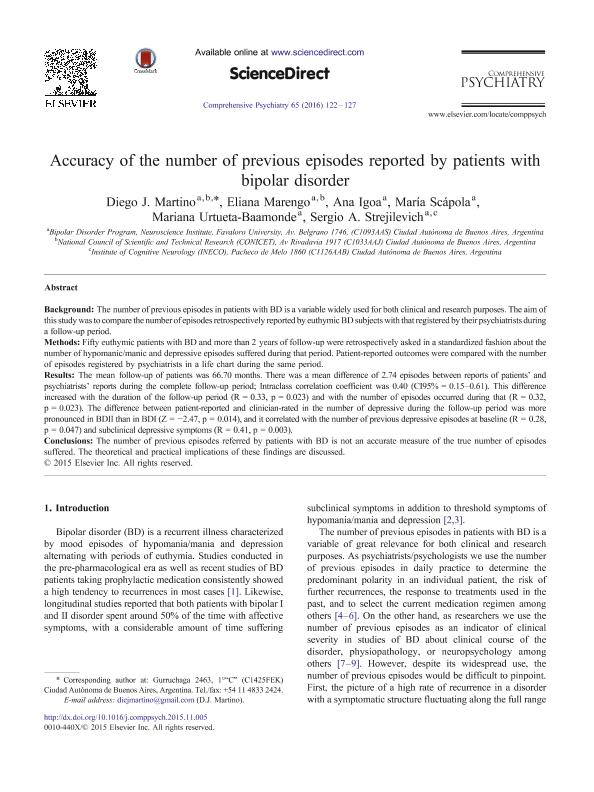Mostrar el registro sencillo del ítem
dc.contributor.author
Martino, Diego Javier

dc.contributor.author
Marengo, Eliana

dc.contributor.author
Igoa, Ana
dc.contributor.author
Scápola, María
dc.contributor.author
Urtueta Baamonde, Mariana
dc.contributor.author
Strejilevich, Sergio

dc.date.available
2018-04-27T19:38:21Z
dc.date.issued
2016-02
dc.identifier.citation
Martino, Diego Javier; Marengo, Eliana; Igoa, Ana; Scápola, María; Urtueta Baamonde, Mariana; et al.; Accuracy of the number of previous episodes reported by patients with bipolar disorder; W B Saunders Co-Elsevier Inc; Comprehensive Psychiatry; 65; 2-2016; 122-127
dc.identifier.issn
0010-440X
dc.identifier.uri
http://hdl.handle.net/11336/43731
dc.description.abstract
Background The number of previous episodes in patients with BD is a variable widely used for both clinical and research purposes. The aim of this study was to compare the number of episodes retrospectively reported by euthymic BD subjects with that registered by their psychiatrists during a follow-up period. Methods Fifty euthymic patients with BD and more than 2 years of follow-up were retrospectively asked in a standardized fashion about the number of hypomanic/manic and depressive episodes suffered during that period. Patient-reported outcomes were compared with the number of episodes registered by psychiatrists in a life chart during the same period. Results The mean follow-up of patients was 66.70 months. There was a mean difference of 2.74 episodes between reports of patients´ and psychiatrists´ reports during the complete follow-up period; Intraclass correlation coefficient was 0.40 (CI95% = 0.15-0.61). This difference increased with the duration of the follow-up period (R = 0.33, p = 0.023) and with the number of episodes occurred during that (R = 0.32, p = 0.023). The difference between patient-reported and clinician-rated in the number of depressive during the follow-up period was more pronounced in BDII than in BDI (Z = -2.47, p = 0.014), and it correlated with the number of previous depressive episodes at baseline (R = 0.28, p = 0.047) and subclinical depressive symptoms (R = 0.41, p = 0.003). Conclusions The number of previous episodes referred by patients with BD is not an accurate measure of the true number of episodes suffered. The theoretical and practical implications of these findings are discussed.
dc.format
application/pdf
dc.language.iso
eng
dc.publisher
W B Saunders Co-Elsevier Inc

dc.rights
info:eu-repo/semantics/openAccess
dc.rights.uri
https://creativecommons.org/licenses/by-nc-nd/2.5/ar/
dc.subject
Bipolar Disorder
dc.subject
Reported Episodes
dc.subject.classification
Medicina Critica y de Emergencia

dc.subject.classification
Medicina Clínica

dc.subject.classification
CIENCIAS MÉDICAS Y DE LA SALUD

dc.title
Accuracy of the number of previous episodes reported by patients with bipolar disorder
dc.type
info:eu-repo/semantics/article
dc.type
info:ar-repo/semantics/artículo
dc.type
info:eu-repo/semantics/publishedVersion
dc.date.updated
2018-04-27T13:59:35Z
dc.journal.volume
65
dc.journal.pagination
122-127
dc.journal.pais
Estados Unidos

dc.journal.ciudad
Philadelphia
dc.description.fil
Fil: Martino, Diego Javier. Consejo Nacional de Investigaciones Científicas y Técnicas; Argentina. Universidad Favaloro; Argentina
dc.description.fil
Fil: Marengo, Eliana. Consejo Nacional de Investigaciones Científicas y Técnicas; Argentina. Universidad Favaloro; Argentina
dc.description.fil
Fil: Igoa, Ana. Universidad Favaloro; Argentina
dc.description.fil
Fil: Scápola, María. Universidad Favaloro; Argentina
dc.description.fil
Fil: Urtueta Baamonde, Mariana. Universidad Favaloro; Argentina
dc.description.fil
Fil: Strejilevich, Sergio. Universidad Favaloro; Argentina. Instituto de Neurología Cognitiva; Argentina
dc.journal.title
Comprehensive Psychiatry

dc.relation.alternativeid
info:eu-repo/semantics/altIdentifier/doi/http://dx.doi.org/10.1016/j.comppsych.2015.11.005
dc.relation.alternativeid
info:eu-repo/semantics/altIdentifier/url/https://www.sciencedirect.com/science/article/pii/S0010440X15300948
Archivos asociados
